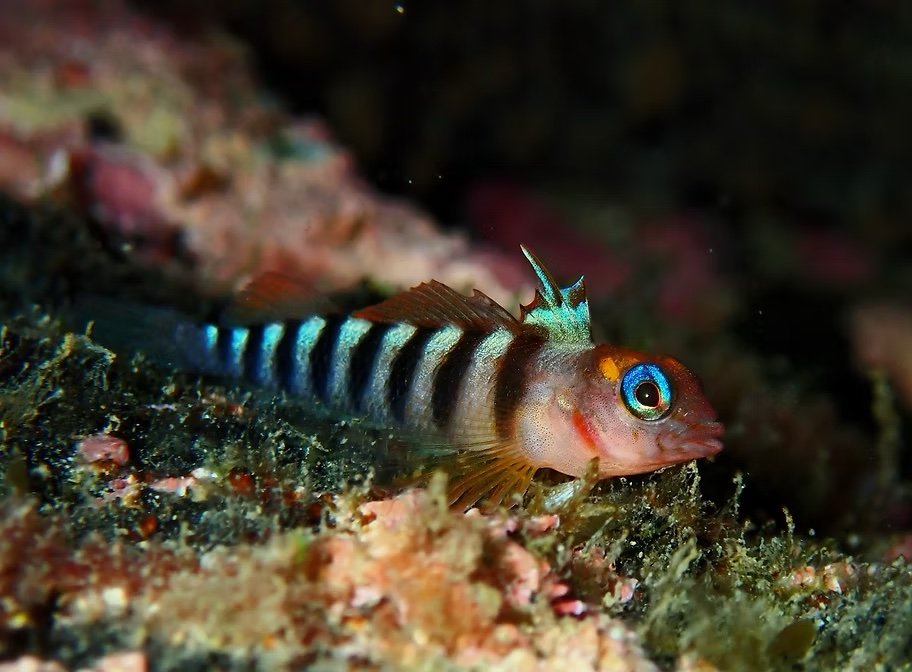Te Kohuroa’s Terrific Triplefins
Words and photos by Poppy Shears.
The blue-eyed triplefin (Notoclinops segmentatus).
Triplefins are one of the most diverse families of fish living on Aotearoa New Zealand’s coastal reefs. But because they are small they are often overlooked.
Triplefins are a very unique family of fish as they spend most of their time sitting on the reef, as opposed to swimming. This is because they do not have a swim bladder (an air-filled organ that helps with buoyancy) like most other fish do, so they move in short darts then rest on the reef again. If you pause for a moment and look closely around the shallow reefs of Te Kohuroa Matheson Bay, you may notice many vibrant triplefins sitting on the bottom looking back at you.
My passion for triplefins has grown as I've started to notice the small important details that make the reef thrive. From triplefins to nudibranchs, each organism plays an important role in contributing to this vital ecosystem.
Poppy Shears, Snorkelling at Te Kohuroa.
The wonderful world of triplefins
There are 27 species of triplefin in Aotearoa. All except three species are endemic, which means they are found nowhere else on earth! Triplefins come in many shapes, colours, patterns and sizes but can be distinguished from other fish by three separate dorsal fins (along their back) and the many scales along their sides. At Te Kohuroa you will most likely see the aptly named Common triplefin (Forsterygion lapillum), as well as the slightly larger Variable triplefin (Forsterygion varium) sitting on ledges, overhangs or in places with lots of small turfing algae.
The Common triplefin (Forsterygion lapillum).
The Spectacled triplefin (Ruanoho whero).
On rare occasions you might also see the Spectacled triplefin (Ruanoho whero) and the Blue-eyed triplefin (Notoclinops segmentatus) but they are mostly found a bit deeper on the reef (3 metres plus) and hiding in a crevice or amongst small patches of kelp. Two of my favourite observations of triplefin at Te Kohuroa are the Cryptic triplefin (Cryptichthys jojettae) and the Yaldwyn’s triplefin (Notoclinops yaldwyni).
“At first I did not believe my eyes, but with a closer look it was easy to spot the distinctive white bar at the base of its tail.”
The Cryptic triplefin (Cryptichthys jojettae).
The Cryptic Triplefin
The Cryptic triplefin is a rare species of triplefin that is usually only found at offshore islands, but I have seen multiple at Te Kohuroa. As its name suggests, this triplefin is extremely well camouflaged and can grow up to approximately 50 millimetres long. Being only my second ever sighting of this species I was extremely surprised when I saw this 15 millimetre, pink and white striped fish sitting camouflaged against the pink turfing algae. At first I did not believe my eyes, but with a closer look it was easy to spot the distinctive white bar at the base of its tail.
The Yaldwyn’s Triplefin
Another unique triplefin that I have seen at Te Kohuroa is the Yaldwyn’s triplefin. Yaldwyn’s triplefins are a more common species of triplefin but once again I have only ever seen them at offshore islands. They have a pink, fawn or orange coloured body with numerous dots and can grow up to about 70 millimetres in length. With their distinctive simple pattern and solid coloured body I was certain I had seen a Yaldwyn’s triplefin dart into a small crevice at the back of the island. Being my favourite triplefin, I was extremely excited to spot this individual and I was also able to get a few shots that really showed the beauty this triplefin has.
The Variable triplefin (Forsterygion varium)
Special Sightings at Te Kohuroa
Despite visiting many bays and snorkelling sites in the Hauraki Gulf, Te Kohuroa is the only place on the mainland where I have seen the Yaldwyn’s triplefin and the Cryptic triplefin. This shows us that Te Kohuroa provides a unique and highly important habitat for the underwater ecosystem.
These sightings of triplefins and numerous other amazing encounters with juvenile packhorse crayfish, octopus and more, prove to us that Te Kohuroa holds true potential to be a thriving reef once more.
I believe that with more marine protection to restore key marine predators, alongside ongoing community input, Te Kohuroa Matheson Bay could be just as beautiful underwater as it is above.
About the Author
Poppy Shears is a 15 yr old underwater photographer and naturalist. She has spent her whole life by the ocean and has visited some incredible coastlines with her family, including Chile, the Caribbean and the Galapagos. Poppy has a special interest in triplefins and you can view her photography and ID guide on her website: www.poppyshears.com







